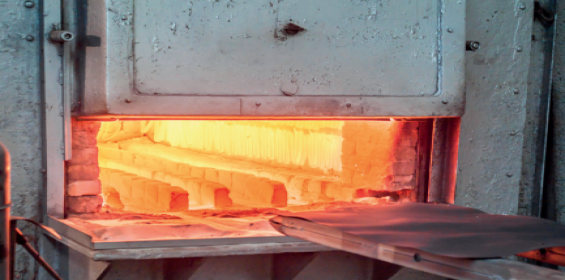Making industrial furnaces more energy-efficient
Published: 23 August, 2023
With industrial furnaces being one of the biggest energy consumers, it’s no surprise that manufacturers are investing in research and development to create more energy-efficient solutions. Chris Johnson* explains why high-temperature bearings will be crucial in making industrial furnaces more energy-efficient
Even as countries strive to meet climate goals and reduce their carbon footprint, the current rate of improvement is not sufficient to meet the targets set out by the Paris Agreement.
According to the International Energy Agency (IEA), in 2022 the global economy used energy two per cent more efficiently than it did in 2021. While this is an improvement, there is still some way to go and energy efficiency improvements need to average 4 per cent a year this decade to align with the IEA’s Net Zero Emission by 2050 Scenario.
This increasing emphasis on reducing carbon emissions and energy consumption, there is a growing demand for energy-efficient industrial furnaces. As a result, manufacturers are investing in R&D to develop advanced furnaces that consume less energy, emit fewer pollutants and ensure better combustion efficiency.
High-temperature bearings
Industrial furnaces operate at extremely high temperatures and often in harsh environments, which can cause significant wear and tear on the machinery. Bearings are a critical component of these machines, as they help to reduce friction and wear between moving parts. However, at high temperatures, traditional bearings can fail, causing damage to the furnace and reducing its efficiency.
High-temperature bearings are designed to withstand extreme temperatures and harsh environments, making them the ideal solution for industrial furnaces.
Bearings are essential components in various mechanical systems, designed to reduce friction and wear. The materials used for manufacturing bearings depend on the temperature requirements of the application. For temperatures up to 150 °C, chrome steel bearings are suitable when paired with an appropriate lubricant. Meanwhile, 440 grade stainless steel bearings can withstand temperatures of up to 300 °C with the right lubrication. Beyond these thresholds, alternative materials must be employed.
At higher temperatures, full ceramic bearings without ball retainers, also known as full complement bearings, are utilised. These bearings find application in temperatures above 300 °C, as well as in situations where lubrication poses a challenge, such as due to contamination. Full complement ZrO2 ceramic bearings can be employed in temperatures up to 600 °C, while full complement Si3N4 bearings have demonstrated successful performance up to 1200 °C.
By employing high-temperature bearings, manufacturers can effectively minimise friction and wear, resulting in reduced energy consumption and enhanced operational efficiency. The selection of the appropriate bearing material ensures optimal performance and reliability in diverse temperature environments.
Driving factors
The demand for energy-efficient furnaces is growing rapidly, driven by a range of factors. One of the most significant drivers is political, with governments around the world setting ambitious climate goals to reduce carbon emissions and combat climate change. This has led to increased regulations and incentives for businesses to reduce their carbon footprint and improve energy efficiency.
Another factor driving demand is the growing industrial sector, particularly in countries such as China and India. As these countries continue to develop, the demand for energy-efficient furnaces will increase, as manufacturers seek to reduce costs and improve their efficiency further.
Finally, technological advancements are also driving demand, with new materials and designs being developed to improve energy efficiency and reduce emissions. High-temperature bearings are just one example of this, with manufacturers investing in R&D to create new and innovative solutions.
Benefits of investing
Investing in high-temperature bearings offers a range of benefits for businesses. In addition to the obvious environmental benefits, they can also help to extend the life of the furnace, reducing maintenance costs and downtime.
In addition, high-temperature bearings can improve overall safety and reliability, reducing the risk of equipment failure and accidents. This can have a significant impact on productivity and employee morale, as well as reducing the risk of costly lawsuits and damage to the company’s reputation.
As countries strive to meet the climate goals set out by the Paris Agreement, industrial furnaces, being significant energy consumers, must become more energy efficient. Specialised high-temperature bearings are essential in this endeavour. These specialised bearings withstand extreme temperatures and harsh environments, reducing friction and wear. In doing so, they can help drive the transition towards more energy-efficient industrial furnaces and contribute towards a greener future.
For further information please visit http://www.smbbearings.com/
*Chris Johnson is managing director at specialist bearing supplier SMB Bearings
https://twitter.com/SMBtechgeeks
https://www.linkedin.com/company/smb-bearings/

Bearings are critical components in industrial furnaces, as they help to reduce friction and wear between moving parts.






